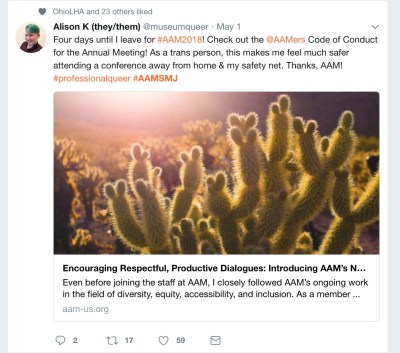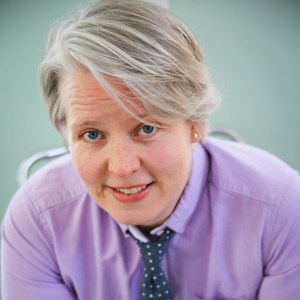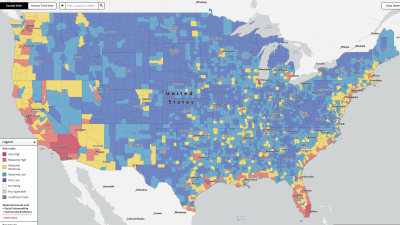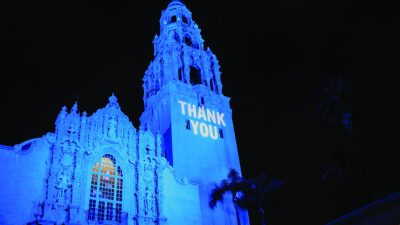
Each year, the Alliance recruits 10-12 people to be Social Media Journalists – to tweet and share conference happenings for those who don’t attend or just want to follow along with all the fun. As one of those chosen for the role in Phoenix, I was excited to use my conspicuous new title to introduce myself to people I didn’t know and to have more of those conversations I love to have at conferences – the ones that push my thinking forward.
 Before the conference, I knew Alison Kennedy (they/them) – a fellow AAM Social Media Journalist — only through Twitter. When I saw Alison’s tweet in support of AAM’s new Code of Conduct for meeting attendees, I thought it would make for a good conversation topic. Lots of organizations have anti-discrimination and anti-harassment policies, but I had never read one that addresses the conduct of members towards marginalized groups – especially gender – in such a specific way.
Before the conference, I knew Alison Kennedy (they/them) – a fellow AAM Social Media Journalist — only through Twitter. When I saw Alison’s tweet in support of AAM’s new Code of Conduct for meeting attendees, I thought it would make for a good conversation topic. Lots of organizations have anti-discrimination and anti-harassment policies, but I had never read one that addresses the conduct of members towards marginalized groups – especially gender – in such a specific way.
Alison and I are both queer and gender non-conforming, but we’re more different than we may seem. I am almost 48, Alison is 28. Alison identifies as trans, whereas I call myself a gay woman (she/her). I wanted to sit down with them, to compare “gender journeys” — yes, I did just make up that term — and to understand more about why Alison thought the Code of Conduct was so necessary.
Here is an excerpt from our conversation at AAM and as it continued at home (slightly edited for clarity):
I saw your tweet in support of AAM’s efforts to publish a Code of Conduct for the conference. I had a little bit of a different reaction. I’ll tell you about it, but first I want to hear a little bit more about your reaction. How did it make you feel to see it?
Seeing that AAM put this stuff in writing makes me feel absolutely safe here [at the conference]. It sets a precedent from the beginning that that kind of behavior is not tolerated no matter who you are. And I know that if it does happen to me, that I have the support of the Alliance to say like, “no this is unacceptable.” They have said that it’s unacceptable from the beginning.
At my museum we’ve been talking a lot about our restroom signs and a couple of people are like “why can’t we just have non-gendered restroom signs?” And my argument with that is that having generic signs doesn’t actually state that you’re inclusive. Saying “gender inclusive” means that I know, as a trans visitor, as a nonbinary visitor, that the museum is going to have my back if I go into that bathroom and someone gives me sh*t about it.
I get that. It’s in a language that speaks directly to you and lets you know about the values of the organization. And you’re in a leadership role in visitor experience at your museum right? So visitors’ perception of the bathrooms (at the Columbus Museum of Art) is definitely part of your job too – not just your personal life. Bathrooms and gender have obviously become a big issue around the country. And if you look at the Code of Conduct, there’s a lot there that addresses gender issues. So it’s obviously something that AAM is trying to focus on.
Skip over related stories to continue reading articleWhen I read it, I thought “Wow, does this awful stuff really happen to people at AAM regularly?” I’ve never felt unsafe at an AAM conference. I mean, I’m not exactly gender conforming. I wear neckties, jeans, and sneakers pretty often when I’m with clients or at conferences. I’m kind of going for a look I jokingly refer to as “lesbian tech start-up” lol. But I guess I don’t look masculine enough to get called out in the women’s restroom. And I live in a big city. It’s just never happened. And I’ve never really been made to feel uncomfortable – at least on purpose. So maybe that’s why I don’t think about safety as much. It’s my experience.
So my first thought with the Code was “is all this detail really necessary?” But then I wondered if I was being limited by my own experience. I’m gay, yes, but I’m not trans. So I don’t know what that’s like. And I do a lot of work in museums around empathy and perspective shifting. And I really like to practice what I preach. So if I can, I’d like to understand more about what it’s like to be transgender in a public forum like this. I know you can’t talk on behalf of everyone, but what’s it like for you? Have you ever had an incident in a bathroom or in public that made you feel unsafe? Or have you known anyone trans that has had an incident?
Oh absolutely. More than once I’ve had people give me dirty looks or try and tell me I’m in the wrong restroom. And those happened even before I was out as trans! I’m very cautious when using a public restroom in a new place, as I don’t want to accidentally come across the wrong bigot and find myself getting beaten up. It’s especially scary when I’m traveling alone.
Thank you for sharing that. It sounds like the bathroom can be kind of a vulnerable place, especially if you’re trans. I think there is a perception that if you fall under the LGBTQ umbrella that we all understand each other perfectly, or have similar experiences. Like we are some kind of monolith of rainbowness! Ha! But I think there is a lot more diversity of experience in the queer community than most people think. I’ve known a couple of trans people, but not very many. So I don’t have a lot of practice with “they/them” as a pronoun – so I mess up a lot – although I do keep practicing.
The Code of Conduct prohibits “deliberate misgendering” – which I realize is different than accidental misgendering. But do you get offended or upset when people use the wrong pronoun?
I mean, I think we all do it. We see a person and we make an assumption based on how they look and we pick a pronoun – especially once we know them. And I understand how gendered our language is – which is why I’m patient with people when they’re trying to learn. Because I know it’s hard and I’ve messed up too. Really the only reason I’m good at it now is because I’ve done so much practice. I worked at a queer youth center. So to your point, practicing is so key. And I don’t care if people mess up, but for me it’s about intent and the way you react when you mess up. If you’re trying and I can see that you’re trying, I am absolutely happy to be patient and help in as many ways as I can, but if it’s deliberate it’s another thing.
Another thing my trans friends talk about is the over-apologizing for messing up the pronoun. Sometimes people go on and on about the reasons they messed up and how terrible they feel. And now I have to do some emotional labor to help them to feel comfortable. And it becomes about them. I prefer when people just correct themselves and move on.
I have a friend who really wants to challenge herself to practice pronouns, but she doesn’t have any close trans friends. So she has this giant stuffed animal—the kind you win at a carnival—and she pretends that the bear is a non-binary bear that goes by them/them. It’s an awesome idea. So she and her husband will have conversations about the bear using “them/them” so they can sort of normalize the sound of the pronouns in their house. I think it’s so cool and imaginative that they do that.
Oh yeah, that’s great. When me and my partner were working at the queer youth center, lots of kids used different “neo-pronouns’ (Ze/Zie, Ne/Nim etc), and so my partner just assigned a different pronoun to all of our pets and practiced that way.
Wow, there are so many pronoun options today. And it makes me realize that it’s really about more than just words. “He” and “she” are actually pretty limiting. I grew up in the 1970s in Indiana as a “tomboy” but never thinking there were any other options for gender or sexuality. This is probably part of the reason that I didn’t really realize I was gay until I was 36. That’s a whole other story!*
So I’ve never felt a man trapped in a woman’s body. But I can’t help but wonder — if there were like 10 different genders to pick from when I was growing up – I definitely would have chosen one that was more masculine than just straight up “female.” And today, there are so many ways that I feel like my gender is not accurately described by the term “woman.” I mean, I shop in three different sections of a store to find clothes – womens, mens, and boys.
So what’s your gender journey? How did it unfold for you?
So like you, I was never particularly feminine when I was a kid. My mom kind of wanted me to be girly. She would always ask me “Do you want to be a boy?” Not in a kind way or a supportive way, but in a way that made it plain that being a boy wasn’t actually an option. And I was like “No, I don’t want to be a boy.” That didn’t fit. Flashforward – by high school I was identifying as gay. But I didn’t really think being trans was an option. I was in Georgia and I only saw negative images of trans people. But in college at Otterbein, in Ohio – which is a pretty queer school – I got interested in gender studies and became friends with more trans people. And then a little bit later, I found the word “non-binary” which fits me so much better! So I realized I don’t have to want to be a guy to be trans. That was really a turning point.
Yeah, when most people hear “trans” they still assign a gender like “trans man” – so to be non-binary you probably have to work harder to get people to understand what that means. It occurs to me as we talk that so much of our struggle to define ourselves has to do with what we’ve been exposed to and whether our exposure to options or “boxes” is positive or negative.
Absolutely. It’s so much easier to be who you are when there are positive role models and images around you.
So let’s get back to the deliberate misgendering. Or the “dead naming” – which is also a term used in the Code (using a person’s old name once they have transitioned). What can you tell me about the malicious side of misgendering from your perspective? Why do you think this needs to be explicitly stated in a Code of Conduct?
Deliberate misgendering is just a lack of respect. It shows me that someone doesn’t respect me enough as a person to put the effort into getting it right. I’m not talking about someone I don’t know, who sees what I look like and assumes a pronoun. Visitors in my museum mess it up all the time, and it doesn’t bother me. They don’t need a conversation on gender, they just want to know where the restroom is. But my coworkers? The people I’ve had conversations with? They should get it right. And continuing to not put in the effort to get my pronouns right hurts. It shows that they don’t care enough or respect me enough to try harder.
And as for deadnaming, I mean, people call Snooki by her chosen name (reality show celebrity from “Jersey Shore), even though it wasn’t her name given at birth. They manage to change what they call people who have gotten divorced with no fanfare all the time. But god forbid a trans person want to be called by something different than what their parents named them. Then it’s ‘too hard’ and ‘they knew me before!’ It seems like people just don’t respect trans people enough to put the effort in.
It’s so important to have that explicitly in the Code of Conduct because it happens to trans people all the time, and people think it’s acceptable. Heck, it happens to cis people all the time too. It’s just as important to have protections for gender non-conforming cis women like you. If you look at the bathroom bills that are passed in different places, the other people being harassed in restrooms about it are nonconforming or masculine cis women. It’s a scary time for all of us. AAM stating that it’s unacceptable gives us room to respond with the support of the Alliance.
My conversation with Alison was a highlight of the conference. Not having had many opportunities to talk to a trans person in-depth, this conversation made some of the things written in the Code of Conduct seem more human. I value that immensely. I started thinking about some of the other issues outlined in the document – “unwelcome sexual attention, collection or distribution of harassing photography” – and all the rest. What if we connected human stories to all of these rules? Having a code gives AAM a way to address violations but it doesn’t necessarily inspire people to want to change hearts and minds. At the end of the day, we don’t want people just to follow the rules, we want people to respect their fellow humans and try earnestly to understand why these protections are put in place.
I’m convinced that the best way to take inclusivity issues to heart is to evaluate our own experience and how our journeys have led to our views. And to have honest and vulnerable conversations with people different from ourselves –face-to-face. I mean look, I’m a member of a marginalized group, but I had lots to learn about a person in a different marginalized group. It’s a process that’s never finished.
Get uncomfortable-learn-grow-repeat.
* We all have a story to tell! To view an on-stage performance of my own “coming out” story as a middle-aged woman, click here.
Andrea Jones is an independent consultant and experience designer working with museums to reinvent storytelling and interpretive methods in the service of greater relevancy for audiences. She is located Washington DC.
Blog and website: peakexperiencelab.com
Twitter: @museumjones
Facebook: Peak Experience Lab
Alison Kennedy is a nonbinary museum activist working in visitor experience in Columbus, Ohio. They believe in encouraging people to live authentically by living their most authentic life out loud.
Blog and website: museumqueer.com
Twitter: @museumqueer
Instagram: @museumqueer
Both Andrea and Alison served as Social Media Journalists at the 2018 AAM Annual Meeting and MuseumExpo.











Truly no matter if someone doesn’t know then its
up to other viewers that they will help, so here it takes place.